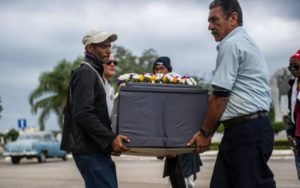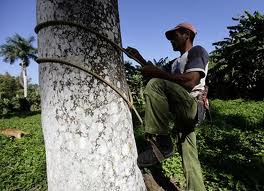 “MURIÓ COMO CAFUNGA!”…FRASE POPULAR CUBANA. VERSIONES.
“MURIÓ COMO CAFUNGA!”…FRASE POPULAR CUBANA. VERSIONES.
El idioma español y dentro de este, el que hablamos en Cuba se caracteriza por la riqueza de frases originadas ya sea de la mitología grecolatina y el folklore: español y africano, componentes de nuestra nacionalidad, además de la historia universal y de ese humorismo que caracteriza a nuestro anecdotario popular.Por ejemplo se ha preguntado usted alguna vez ¿Cómo murió Cafunga? Pues precisamente la frase “Morir como Cafunga” es muy popular entre los cubanos desde hace muchísimos años atrás.
En algún libro leí que Cafunga era un esclavo liberto que vivía en la zona de Cienfuegos, específicamente en Cruces, y se a cortar palmiche. El palmiche, como muchos saben, es el fruto de la palma y es un excelente alimento para los cerdos, dándole a su carne un sabor muy agradable.
Pues bien, Cafunga cortaba palmiche. Escalaba las altas palmas machete en mano y auxiliado de una cuerda o soga, bajaba los racimos hasta el suelo para evitar que se dañaran con la caída. Pero he aquí que cierto día en que Cafunga realizaba su habitual y peligrosa faena, perdió el equilibrio y se precipitó al vacío muriendo inmediatamente por el impacto.
Por esa razón los cienfuegueros solían decir en tono admonitorio “vas a morir como Cafunga”, cuando alguien corría el riesgo de perecer aplastado física o moralmente.
“¡Murió como Cafunga!”, constituye una exclamación escuchadísima en Cuba cuando alguien termina en un desenlace fulminante.
Pero en realidad, …. ¿era cienfueguero? ¿Quién es ese personaje que, desde hace muchas décadas, encontramos en boca de nuestros coterráneos? Los datos los proporciona Don Fernando Ortiz, sólo aclarando su carácter anónimo, sin especificar fuente alguna.
Según Don Fernando Ortiz, ese gran estudioso de nuestras raíces cubanas, existen al menos dos versiones del origen de esta frase: la primera, es que la voz Cafunga viene por alteración del vocablo Kakanfó, título conferido al guerrero Lucumí cuyo valor lo convertían en héroe de su pueblo por tanto en una figura admirada dentro del folklore afrocubano.
La otra versión cuenta que un moreno desmochador de palmiche en la zona de Santi Spiritus, quien tenía como sobrenombre Cafunga, un día al no ajustarse bien las trepaderas que lo aseguraban, cayó estrepitosamente desde lo alto de una palma real (árbol nacional de Cuba).
Ya sea por cualquiera de las dos versiones lo cierto es que la frase “Morir como Cafunga” ha sobrevivido por más de un siglo en el argot popular del cubano y es mencionada cuando nos referimos a alguien que muere en un acto altamente arriesgado.
Pues dígase que Cafunga, hombre humilde, jamás sospechó que sería eternizado en la posteridad. Fue alrededor de 1850 cuando, un mal día, frente a la finca El Espino, en Alicante, término municipal de Sancti Spiritus, estaba Cafunga ejerciendo su alta magistratura, pues altitud era lo que se sobraba en su desempeño. Tras desmochar varias palmas, subió a una de las que nombramos reales. Muy para su desventura, se reventó un anillo de los que sujetan los muslos en las llamadas trepaderas. Desde lo alto, Cafunga cayó de cabeza sobre el suelo. El cadáver fue trasladado a la ciudad de Sancti Spiritus, en cuyo cementerio recibió sepultura, una vez ejecutada la autopsia.
De todas maneras, cada vez que un cubano observa que alguien concluye de modo tremendamente adverso, suele seguir profiriendo: “¡Murió como Cafunga!”.
 “DIED LIKE CAFUNGA!”.. CUBAN POPULAR PHRASE. VERSIONS.
“DIED LIKE CAFUNGA!”.. CUBAN POPULAR PHRASE. VERSIONS.
The Spanish language and within it, the one we speak in Cuba is characterized by the richness of phrases originated from either Greco-Roman mythology and folklore: Spanish and African, components of our nationality, in addition to universal history and that humorism that It characterizes our popular anecdote. For example, have you ever asked yourself, how did Cafunga die? Well, precisely the phrase “Die as Cafunga” has been very popular among Cubans for many years.
In some books, I read that Cafunga was a freed slave who lived in the area of Cienfuegos, specifically in Cruces, and palmiche was cut. Palmiche, as many knows, is the fruit of the palm and is an excellent food for pigs, giving its meat a very pleasant flavor.
Well, Cafunga cut palmiche. He climbed the high machete palms in his hand and helped with a rope or rope, lowered the clusters to the ground to avoid being damaged by the fall. But behold, one day when Cafunga performed his usual and dangerous task, he lost his balance and rushed into the void, dying immediately from the impact.
For that reason, the Cienfuegos used to say in a warning tone “you are going to die like Cafunga” when someone ran the risk of being crushed physically or morally.
“He died as Cafunga!” It is a very heard exclamation in Cuba when someone ends up in a fulminating outcome.
But really, … was it a Cienfueguero? Who is that character that, for many decades, we found in the mouth of our countrymen? The data is provided by Don Fernando Ortiz, only clarifying its anonymous nature, without specifying any source.
According to Don Fernando Ortiz, that great student of our Cuban roots, there are at least two versions of the origin of this phrase: the first is that the Cafunga voice comes from the alteration of the word Kakanfó, a title conferred on the warrior Lucumí whose value made him a hero of his people therefore in an admired figure within Afro-Cuban folklore.
The other version tells that a dark palmiche topper in the area of Santi Spiritus, whose nickname was Cafunga, one day when the climbers that secured it did not fit well, fell sharply from the top of a real palm (national tree of Cuba).
Whether for either of the two versions the truth is that the phrase “Die as Cafunga” has survived for more than a century in the popular Cuban slang and is mentioned when we refer to someone who dies in a highly risky activity.
Well, say that Cafunga, a humble man, never suspected that he would be eternalized in posterity. It was around 1850 when, on a bad day, in front of the El Espino estate, in Alicante, Sancti Spiritus municipality, was Cafunga exercising his high magistracy, because the altitude was what was leftover in his performance. After topping several palms, he climbed into one of the ones we named real. Much to his misfortune, a ring of those who hold the thighs in the so-called climbers was burst. From above, Cafunga fell head on the ground. The body was transferred to the city of Sancti Spiritus, in whose cemetery it was buried after the autopsy was executed.
Anyway, every time a Cuban observes that someone concludes in a tremendously adverse way, he usually continues to utter: “He died as Cafunga!”
Agencies/ Wiki/ CienfuegosHoy/ Internet Photos/ Arnoldo Varona/ www.TheCubanHistory.com
THE CUBAN HISTORY, HOLLYWOOD.



 < "DIED LIKE CAFUNGA!"... Cuban Popular Phrase. VERSIONS.
< "DIED LIKE CAFUNGA!"... Cuban Popular Phrase. VERSIONS.



